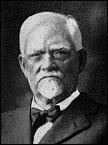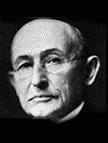by Justin Beckman.
William Holabird (1854-1923) and Martin Roche (1853-1927) left their mark on society with the buildings they made for communities in the late 19th and early 20th centuries. Their work on early American skyscrapers is one that left its impact on the nation. Their contribution to the Copper Country, however, was not a skyscraper, but the First Congregational Church in Lake Linden.
Biography

William Holabird was born on September 11, 1854, in Amenia Union, New York, as the son of Samuel Beckley Holabird. Like his father before him, William Holabird joined the West Point Military Academy in 1873 as a cadet. However, after two years, Holabird resigned over a dispute with authorities of the Academy, and moved to Chicago where he worked as a draftsman for William LeBaron Jenney.1 Jenney, an American architect and engineer, became known as the father of the skyscraper. While working with Jenney, Holabird gained a strong functional approach to design, which had an emphasis on durability, economy, maximum openness of unencumbered interior space, and generous window area for maximum light and ventilation.2
Martin Roche was born August 1, 1853, in Cleveland, Ohio, and moved to Chicago, Illinois, in 1857. It was here that he attended elementary school and entered into the Chicago Art Institute. In 1867, Roche left the Art Institute and began his career as an apprentice cabinetmaker.3 In 1871 Roche was hired as an apprentice to Jenney.

In 1880, Holabird started his own architectural firm with Ossian Simonds, named Holabird & Simonds. In 1881, Roche joined the firm with Holabird. In two years, Simonds left the firm, and the company was renamed Holabird and Roche.
In the beginning Holabird & Roche would see little success with their business. Work was slow and to gain company revenue Roche designed furniture for manufacturers. However, in 1885, business picked up when the firm was commissioned to design its first major building: a two-story shop and apartment block in Chicago. With Holabird’s two years of engineering education and planning skills and Roche’s artistic talents, the duo would help launch a new style of architecture known as the “Chicago School.” They designed skyscrapers and large hotels for cities across the country. Their effects were felt across the nation but a majority of their work focused in the Midwest and primarily in the Chicago area, where their firm was based. Of the many buildings designed in the Chicago area, twenty still stand in its downtown loop.4
One of the firm’s premiere buildings was the Tacoma Building, located on the northeast corner of LaSalle and Madison Streets in Chicago. Construction started on April 10, 1888, by the George A. Fuller Company under the watchful eye of engineer Carl Seiffert and the building opened late the following year. The Tacoma Building stood 12 stories tall (165 ft.) plus an additional two attic floors on its cast-iron columns. The building’s columns rested on a grill of wrought-iron beams that were carried by reinforced concrete shafts. The floor beams were made of steel.5 The mullions and lintel beams were then made out of cast iron. All connections were riveted together instead of welded or bolted. The building was made of an iron and steel skeleton and load-bearing, brick walls. The Tacoma Building was demolished in 1929 to make room for the One North LaSalle Building.
The Marquette Building in Chicago, built in 1895, is also representative of their work. It was constructed by the George A. Fuller Company, and is currently owned by the John D. and Catherine T. MacArthur Foundation.6 The Marquette Building has a façade made of horizontally banded brown terra cotta with wave-like moldings. It has pier and spandrel, Chicago Style fenestration.
Holabird died on July 19, 1923, in Evanston, Illinois, and Roche died in his home in Chicago on June 5, 1927. In 1929 Holabird’s son, John, reorganized the firm and renamed it Holabird & Root. This is the current name of the architecture firm, which still resides in Chicago.
Buildings
Notes
- “Architectural Significance,” Illinois Renaissance, University of Illinois.
- Carl W. Condit, “Holabird and Roche,” in Placzek, Macmillan Encyclopedia, 2:403-405.
- “Architectural Significance,” Illinois Renaissance, University of Illinois.
- Carl W. Condit, “Holabird and Roche,” in Placzek, Macmillan Encyclopedia, 2:403-405.
- Carl W. Condit, “Holabird and Roche,” in Placzek, Macmillan Encyclopedia, 2:403-405.
- “Marquette Building,” Chicago Architecture Foundation.